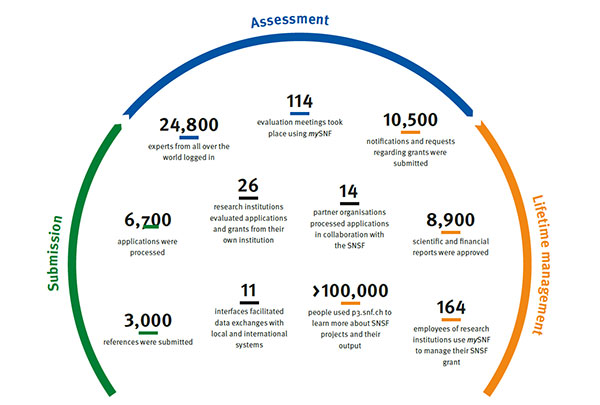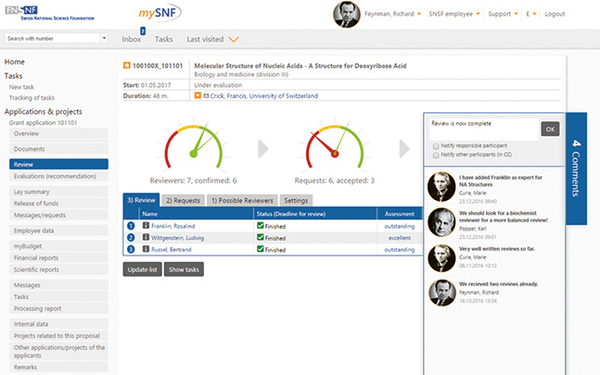mySNF – ten years old and at the heart of all processes
From application submission and evaluation to project management – the mySNF web portal today guides researchers and reviewers through all funding-related processes. But its̓ been a long journey getting to this point.
mySNF platform
2016 highlights

In 2011, the SNSF entered the realm of paperless processing once and for all by introducing fully electronic processing and monitoring of applications and approved projects via the mySNF platform: the laborious process of completing forms and other tasks on paper was now a thing of the past. From the moment the system was introduced, researchers were able to jettison their paperwork, including trips to the post office, and efficiently manage and complete their SNSF proposals and projects.
From punch card to online system
“But the road from a paper-based management system to an integrated online system with various process control and information functions was long and winding,” says Mario Andenmatten, head of the IT Business Services division. From its beginnings in the 1950s until 1972, the typewriter ruled supreme at the SNSF, as it did everywhere else. According to Andenmatten, 1972 was the year that heralded in the digital age: “The introduction of a punch card system made it possible for the SNSF to store and process data in a structured manner.” But it had to wait another ten years (until 1982) for the first real data management system to arrive, and until 1991 for a more powerful computer system for data management.
Progress: at a leisurely pace at first...
By continually developing its management systems – initially at ten-year intervals – the SNSF had been able to steadily increase the number of “paperless” dossiers by the turn of the millennium. “But paper continued to hold sway for a while yet,” says Benjamin Rindlisbacher, head of the Data and Systems division, looking back. For example, applications handed in on paper had to be typed into the existing administration systems, which was very costly and time-consuming. And for many aspects of the evaluation process, documents still had to be sent in by mail or fax, and compliance with deadlines was based on the date stamp. “What is more, updating and analysing information was a long-winded process,” says Rindlisbacher.
...then suddenly gathering momentum
But from the turn of the millennium, digitalisation began to gather pace at the SNSF as well. Between 2002 and 2012, the organisation saw a quick-fire development of its management system. Among the milestones were the introduction of a new electronic application management system (2002), the launch of the mySNF web platform for researchers (2007) and reviewers (2008) and the establishment of the new P3 research database (2012). Today, P3 contains publicly accessible information on approximately 65,000 funded projects and on the over 90,000 researchers involved in them, thus making the funding activities of the SNSF fully transparent. Since 2016, the database has been connected to the opendata.swiss portal, where data collected by various authorities is available free of charge.

mySNF covers almost all processes
Initially, mySNF was solely a platform on which researchers could submit their applications, but from 2008 onwards, the SNSF started extending it step by step. “Today, mySNF covers practically all research funding processes, from application submission to evaluation and lifetime management, and that makes it quite unique,” Rindlisbacher adds. With the number of applications rising steadily, the SNSF’s workload didn’t necessarily shrink, but the work became less arduous: “Today, more resources flow into the quality side. With the advent of digitalisation, entering and managing application and project data became a lot more reliable and efficient.” The central idea was to enter data once and then use them repeatedly. What is more, mySNF is now the main tool for organising evaluation processes and for conducting the time-consuming search for international reviewers. In 2016, around 26,500 requests to review a total of 3,000 applications were dispatched, resulting in 9,600 external reviews being provided to the SNSF.
Pressures and advantages
mySNF was introduced mainly to lighten the administrative workload of researchers filing applications or conducting projects. And the reviewers, too, benefited from an integrated system in which they could efficiently manage the entire evaluation process. Nevertheless, mySNF is also exposed to the pressures of mounting digitalisation: ever-larger amounts of data run counter to the universal desire for less administration. And the stringent data protection requirements, though fully justified, limit the extent to which the available data can be used for analytical purposes or management support. It is in everyone’s interest to find the right balance here – today and in the future.
What the future will bring...
“The continual technological advancement of the ten-year-old mySNF web portal is and will continue to be a central issue,” says Andenmatten. It would also be necessary to provide greater support for fast-growing trends such as mobile working. The processes facilitated by mySNF are continually being optimised and developed. For example, the SNSF is increasingly feeding data provided by partner organisations and research institutions into its web platform. “The future will be all about interconnecting data and services across borders – which is why we are forging ahead with the integration of ORCID, a global non-profit information platform for researchers," Benjamin Rindlisbacher adds. He is convinced that mySNF development will follow the path from an administration system to an information system, from a tool to a process control system, and from a local system to an online service network. But the goal will remain the same: “to reduce the administrative workload for researchers with the help of new methods and technologies, optimise processes, and raise quality standards within research funding!”